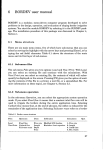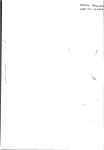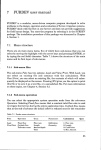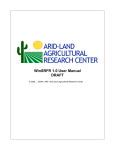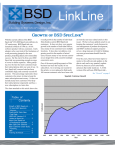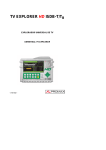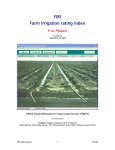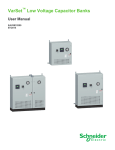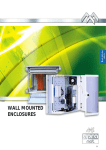Download BASDEV user manual
Transcript
BASDEV user manual BASDEV is a modular, menu-driven computer program developed to solve problems in the design, operation and evaluation of level basin irrigation systems. You start the module by selecting it in the SURDEV package. The installation procedure of this package was discussed in Chapter 4,Section 1. 5.1 Menu structure There are five main menu items, four of which have sub-menus that you can select by moving the highlight with the arrow keys and pressing [Enter], or by typing the red (bold) character. Table 5.1 shows the structure of the main menu and its first layer of sub-menus. 5.1.1 Sub-menu files In the sub-menu Files, there are two options: Load and ViewlPrint. With Loud, you can select an existing file and continue with the calculations. With ViewlPrint you can select an existing file, the contents of which will be displayed on the screen. Pressing [F5] gives you the option to print this file or to save it as a text file or spreadsheet file. For more information on these topics, see Chapter 4,Section 4.3. 5.1.2 Sub-menu units The sub-menu Units gives you a choice of units for flow rate, length, depth and time, which include: - Flow rate: litres per second, cubic metres per minute, cubic feet per second, or US gallons per minute. - Length: metres or feet. These are used for basin length and width. Table 5.1 Basdev menu structure Files Units Infiltration Calculation Load ViewPrint Flow rate Length Depth Time Modified SCS families Time-rated families Kostiakov equation 2. Dimensions Quit 1. Flow rate 3. Cutoff time 4. Min. Depth 51 - Depth: - Time: millimetres, centimetres, or inches. These are used for the various supplied and infiltrated depths. minutes or hours. These are used not only for advance, cutoff, depletion and recession time, but also for the infiltration equations. The selected units are maintained throughout the program and are also saved with the file. When the program is started, default units are litres per second for flow rate, metres for basin dimensions, millimetres for infiltrated depths and minutes for time. 5.1.3 Sub-menu infiltration In the sub-menu Infiltration, you can select one of three infiltration input modes (Table 5.1).All the modes are based on the infiltration characteristics of a soil as described by the Kostiakov equation (Equation 3.1) Di = kTA where Di is the cumulative infiltration after an infiltration opportunity time T, A is the infiltration exponent and k is the infiltration constant. In BASDEV, you can enter the soil infiltration characteristics A and k indirectly by using the Modified SCS Intake Families and the Time-Rated Families, or directly by giving values to A and k. For more background information on this subject, the reader is referred to Chapter 3, Section 1.1.The default infiltration input mode is the Modified SCS family. 5.1.4 Sub-menu calculation The sub-menu Calculation is the only place in BASDEV where the input data can be entered but, before doing this, you need to select one of four different calculation modes (Table 5.1). What the first three modes have in common is that the calculated minimum infiltrated depth at the downstream end of the basin always equals the required depth. In other words, no under-irrigation will occur and there will always be over-irrigation in the upstream part. When to use the various modes is summarised below: Calculation Mode 1: Flow rate Calculation Mode 1 is primarily for design purposes when the dimensions of the basin are known and you want to know the approximate flow rate that is needed to achieve a reasonable performance. The program will also give you 52 ‘ 1 the required cutoff time and the primary performance indicators as well as various depth and time parameters. We emphasise that Mode 1does not give a “best solution”. It only serves as a “first shot” at a reasonable application efficiency. Depending on the type of soil and the required depth, the resulting efficiency in this mode varies between 70 and 95 per cent. This efficiency can be increased in Calculation Mode 3 (eg, by increasing the flow rate). If an inexperienced user were to start straightaway with Mode 3, he may inappropriately select values of input variables that give a poor performance or even error messages. Starting with Mode 1avoids too many trials or error messages. Calculation Mode 2: Dimensions Calculation Mode 2 is the reverse of Calculation Mode 1:the flow rate is now known and you want to know the approximate basin dimensions that are needed to achieve a reasonable performance. The program will also give you the required cutoff time, together with the primary performance indicators and infiltrated depths. BASDEV uses a standard lengtwwidth ratio of 1 (ie, square basins) for the calculation of the basin dimensions. The resulting application efficiency is similar to that in Mode 1.Here again, the calculated values for basin dimensions and cutoff time are only a “first shot”. In Mode 3, you can change the size and shape of the basin to try to increase the application efficiency (eg, by decreasing the basin dimensions). Calculation Mode 3: Cutoff time Calculation Mode 3 is one of the two main modes of BASDEV. It will be the most frequently used and is the starting mode for the experienced user. Here, both the flow rate and basin dimensions are input. The required cutoff time is the resulting decision variable, while also the primary performance indicators and depth and time parameters are given. The calculated cutoff time is such that the minimum infiltrated depth is equal to the required depth. This mode is suitable for a quick try out of the various options for design and operation. Calculation Mode 4: Minimum depth In Calculation Mode 4,the other main mode, the cutoff time is specified as input in addition to the basin dimensions and the flow rate. Thus, all design variables are input, which means that the required depth at the end of the field will usually not be achieved, and under and/or over-irrigation will occur. The main indicator is the minimum infiltrated depth, occurring at the far end of the field. It is therefore given as the first output parameter, followed by the primary performance indicators and infiltrated depths. This mode is most suitable for a performance evaluation of an existing level basin irrigation system and for testing the performance sensitivity to a change in the field parameters. Together, Modes 3 and 4 constitute the core of BASDEV. 53 5.2 Input windows When a calculation- mode --as been selected, BASDEV will display two windows on your screen for data entry: Field. Parameters and Input Decision Variables. The input data to be provided in the two windows are summarised in Table 5.2. Usually, you will only need to change the values of the field parameters to carry out sensitivity analyses after you have obtained satisfactory results in Mode 3 or 4 (see Chapter 4, Section 3.2). Calculation examples can be found in Chapter 8, Section 1.1. 5.2.1 Field parameters Infiltration Upon selection of the Modified SCS families type of infiltration data, BASDEV will use the intake families as discussed in Chapter 3, Section 1.1. One of the eight families can be chosen. If a wrong number is typed, an error message with a list of acceptable numbers is shown. Instead of typing a number, you can also use the help screen by pressing [Fl] while keeping the cursor on the family number. A screen with family numbers will then pop up from which you can make your selection. The same screen also shows the corresponding approximate soil types, as shown in Figure 5.1. When a family number has been selected, the corresponding values for Kostiakov’s A and k are used internally by the program (see Table 3.2). You can check this by selecting a family number, going back to the sub-module Infiltration type, selecting Kostiakov mode, and returning to the input window again, which then shows the corresponding A and k values. If you select T h e - R a t e d Families, you must specify the time required to infiltrate 100 mm (Tloo in the Field Parameters window). Although originally seven time-rated intake families were presented (see Table 3.41, the program Table 5.2 Input variables for the Basdev calculation modes Input variables Field Parameters Infiltration Flow resistance, n Required depth, Dreq Input Decision Variables Length, L Width, W Flow rate, Q Cutoff time, T,, Mode 2 Mode 3 Mode 4 O O O O O O O O O O O O Mode 1 O O O O O O O O O O 5.2.2 Decision variables The decision variables in surface irrigation are normally the field dimensions (length and width), flow rate and cutoff time. Which of these parameters appear under the heading Input Decision Variables depends on the selected calculation mode (see Table 5.2). Basin dimensions You can prescribe values for the basin length and width in Calculation Modes 1, 3 and 4. In Mode 3, increasing the length will lower the performance, because the advance time with the given flow rate will be longer. Applying a larger flow will then enable a greater length. In Mode 4,when using the program for evaluation purposes, you either prescribe the basin dimensions of an existing situation or you keep them as determined in Mode 3. Flow rate Flow rate values can be given in Calculation Modes 2 , 3 and 4.Decreasing the flow rate too much would result in the flow not reaching the end of the field. Contrarily, there is also a practical upper limit, above which the performance will hardly improve (see Chapter 8, Section 1.1).In Mode 4 you either keep the flow rate as determined in Mode 3 or, when using BASDEV for evaluating an existing situation, take the value from the field. Cutoff time Values for the cutoff time can only be given in Calculation Mode 4;there are, however, practical limitations to changing its value. When you go to Mode 4 after having run Mode 3, the displayed cutoff time corresponds to a situation where the minimum infiltrated depth at the downstream end of the basin matches the required depth. Increasing the cutoff time will result in over-irrigation and a lower application efficiency. On the other hand, if you decrease the cutoff time of Mode 3 in Mode 4,you will introduce under-irrigation, yielding a higher application efficiency but a storage efficiency becoming lower than 1. The cutoff time should not be much shorter than the advance time calculated for the same input combination. This would give an unacceptably poor result or even an error message, because insufficient water will reach the end of the field, or no water at all. 5.2.3 Input ranges As shown in Table 5.3, ranges have been fixed for all input variables and are in metric units. If other units are chosen in the menu, the indicated ranges are converted in the program. 56 Table 5.3 Accepted ranges of input parameters Input parameters Field Parameters SCS family # Time-rated T Infiltration coefficient k Infiltration exponent A Flow resistance, n Required depth, D,,, Input Decision Variables Basin length, L Basin width, W Flow rate, Q Cutoff time, T,, Accepted values 0.2 - 4.0 10 - 2000 min 0.8 - 45.0 “/minA 0.2 - 1.0 0.01 - 1.00 40 - 500 mm 55510 - 800 m 500 m 600 VS 800 min Fixing of the ranges based on a large number of runs has been done to avoid too many impossible combinations and corresponding error messages. For all practical purposes, the indicated ranges of the individual parameters will be more than sufficient. If you combine extreme values of the various parameters, you may not get a result. In that case, BASDEV will flash you a message on the screen indicating how to change these values in order to get a result. The above ranges are ignored for output results, so, no warning will be given if an out-of-rangevalue obtained is subsequently used as input in another mode. 5.3 Output window Once all input has been entered, press [F21for the calculation and output. The screen again shows the two input windows, but a third window has now been added showing the results (Figure 5.2). These are depicted in various groups, separated by a blank line. The first group contains the desired decision variables, according to the selected calculation mode. In Mode 1 they are the flow rate and the cutoff time, in Mode 2 the basin dimensions and the cutoff time, in Mode 3 it is the cutoff time, and in Mode 4 it is the minimum infiltrated depth. The second group contains the primary performance indicators as discussed in Chapter 3, Section 3. In Modes 1,2 and 3, this is the application efficiency (with the maximum and average infiltrated depths); in Mode 4 the storage efficiency and the distribution uniformity are added. Finally, there is a group with various time parameters. The output results for the various modes are listed in Table 5.4. Note, the distribution uniformity (DU) is not given in Modes 1, 2 and 3, because, it equals the application efficiency for basin irrigation, as long as the required depth is achieved (which 57 7 38 ._ E Y - .-E 25 13 n * Lover-irrigation Figure 5.3 1 under-irrigation Graphic output of advance curve and infiltration profile the lower one shows the infiltrated depths along the length of the field. Where applicable, under and over-irrigation are indicated. The graph can be saved if you press [F81 or [F91, depending on whether you want to print it in colour or in black-and-white. Figure 5.3 shows a graph that was made by running BASDEV in Mode 4 with default values, except for the cutoff time, which was taken as 50 minutes. You can save the tabulated simulation results together with the input data by pressing [F41. In a small window, the path (folder + file name) can be confirmed or changed, as described in Chapter 4,Section 3.3. You can overwrite the previous file or append the current results to it. Further processing of the saved results file must be done under the Files menu, using View /Print (see Chapter 4, Section 4). 5.4 Error messages When you start with Mode 1or 2 to get proper initial estimates, BASDEV will usually give an output as a result of the calculations. Yet, particularly when working in Modes 3 and 4, BASDEV may flash you error messages on the screen. Such an error message will usually start with Change one or more input parameters and be followed by suggestions on which parameter to decrease or increase. 59 The suggestion will depend on the mode and on the input value. Possible problems can be grouped into three categories (ie, computational problems, physical problems, and cutoff time problems). Computational problems In the calculation algorithm of BASDEV, the parameters are scaled to facilitate a solution to the equations. It is impossible to do this in such a way so that all combinations of all parameters can be solved. As a result, a calculation problem may occur with some combinations of extreme values of parameters, although the input ranges given in Section 5.2.3 have been fixed so as to avoid too many problems. Note, a problem such as this is always related to a (virtual) poor irrigation performance: an unacceptably low application efficiency or excessive under-irrigation. This will not happen if you use a combination of input parameters that will result in the performance you will normally try to achieve. Physical problems The combination of input values could be such that it is physically impossible to get a result. This can happen, for instance, with small flows on large basins, or with very light soils and large basins. In these cases, Modes 1,2, and 3 will flash you a message on the screen because the required depth cannot be realised, or in Mode 4 when the flow will not reach the end of the basin at all. This is not a calculation problem, but a signal that it is physically impossible to get a result with the given set of input values. Cutoff time problem The calculation algorithm and the solution procedures of BASDEV cannot handle a cutoff time that is substantially shorter than the advance time. For instance, a high flow rate in a short basin will give a short advance time, but because of the high flow rate, the cutoff time (being the required volume divided by the flow rate) may be even less. The same problem could occur if the specified cutoff time in Mode 4 is too short. No single remedy can be given to circumvent this problem, and suggestions on the screen therefore vary with the calculation mode. As long as the flow is cut off when advance has passed 90 % of the basin length, the program will give a result. With cutoff when advance is between 90 and 100 % of the field length, computation results will be somewhat inaccurate, but they will be acceptable for practical purposes. Many runs with BASDEV have shown that the occurrence of this type of problem gives inadequate results anyhow. You can verify this by generating such an error message in Mode 3 or 4,and then gradually changing one of the input values as recommended by the message. This will lead to a rather poor first result: too much under-irrigation in Mode 4, or a very low application efficiency in Mode 3. 60 5.5 Assumptions and limitations The BASDEV program is based on a model that is assumed to represent the process of basin irrigation. This model (described in detail in Appendix A) involves assumptions on the validity and accuracy of the algorithm used, and also on the procedures to solve the equations. The use of BASDEV is thus limited to conditions where these assumptions are valid. In addition, the model itself is a schematisation that includes a number of practical assumptions on conditions that require fulfilment. These may also restrict the use of BASDEV. We therefore briefly discuss the theoretical assumptions and the practical limitations of the use of BASDEV for design, operation, or evaluation of a level-basin surface irrigation system. As explained in Appendix A, the model assumes that: - The modified Eulerian cell approach with the modified zero-inertia model is appropriate for simulating the advance phase. - The modified Manning equation and flow resistance coefficients are sufficiently accurate in describing the surface flow component. - The infiltration characteristics and the approximation of infiltration profiles are sufficiently accurate in describing the infiltration component. - The numerical solution procedures are sufficiently accurate in establishing the volume balances. - The simplifications of storage and recession phase are realistic. Apart from these more theoretical assumptions related to the algorithm and its solutions (ie, accepting the model as it is), there are a number of practical conditions that should be fulfilled. The most important are the following: - There is no surface runoff. This is a reasonable assumption, which is achieved by ensuring that the bunds all around the basin are sufficiently high and by working with reasonable water depths. - Inflow is evenly distributed over the width. The program works with unit flows, whereby the total inflow is divided by the basin width. This allows a two-dimensional calculation of the surface flow on a one-metre-wide strip (surface flow in length direction and infiltration in vertical direction). Slight variations (eg, when inflow is distributed over the width by an adequate number of siphons) will not produce a severe limitation on longer fields, because flow from the siphons will rapidly spread out to form one straight front. If water is supplied from one inlet point, however, a head ditch can be made to make basin inflow more uniform. For situations with a point inlet, Clemmens et al. (1995) state that for length-width ratios of >2, the location of the inlet has no effect on advance. For basins that are almost square, they recommend using the diagonal distance as the field length, and using a calculation width that is the actual basin area divided by the diagonal distance. - Inflow is constant during the supply period. A deliberate inflow cutback is 61 not needed with basin irrigation, because there is no surface runoff. In practice, fluctuations in flow rate may occur. Minor fluctuations around the intended value will not be a problem, because their effect is levelled out during advance, especially if cutoff occurs later than advance time. Reddy and Clyma (1982) showed that this also applies to larger variations. The influence of systematically lower or higher inflows can be assessed with BASDEV itself. - Infiltration and flow resistance are uniform over the basin area. Substantial variations in infiltration will certainly affect the performance, but to what extent this occurs depends on the values of the other parameters. Variations in flow resistance usually have less influence. Resistance that is generally higher than assumed will result in the advance time being later, consequently, performance will be poorer. Calculations of design and performance sensitivities can indicate the accuracy required in these inputs. - The basin surface is level in all directions. A slight gradient lengthways is acceptable (eg, up to half the maximum flow depth), the calculations thereof need not be adjusted because the advance will be faster and the practical . result would be a slightly better performance than calculated. Slopes across the field, however, should always be avoided. Undulations (high and low spots) seriously affect the performance, because the surface flow first has to fill the low spots before it can overcome the higher spots. This can be avoided by proper levelling. Deviations of about 15 mm, as achieved with lasercontrolled levelling, have little effect, but deviations of more than 40 mm are not acceptable (Dedrick et al. 1982). ' Finally, we must emphasise that BASDEV only deals with the technicalhydraulic aspects of basin irrigation. In a proper design or operation, the program result only constitutes one element of the total considerations, which should also include topographic, agricultural, economic, and social aspects.. In addition, one should take into account the relationships between field irrigation, the water distribution in the tertiary unit and the supply regimes in the main system. Therefore, an overriding assumption of BASDEV is that the user is fully aware of its limitations and must give due consideration to all these other aspects as well. 5.6 Program usage The following eight steps are important in the usage of the BASDEV program. 1. Start the SURDEV package. Select BASDEV from the main menu of SURDEV. 2. If you want to use an existing file, retrieve it with the Loud command under the Files menu. If you want to make a completely new file, go 62 3. 4. 5. 6. I 7. l l 8. L straight to the Calculation menu bypassing the Files menu and you will get the default data. If you normally work with the default unit settings, you can skip the Units menu. Select Units only if you want to work with other units. Specify which type of infiltration characteristics you will be inputting in the Infiltration menu. The program default is the Modified SCS families infiltration type. Go to the Calculation menu and select a mode to work in. Most of the work will be done in Modes 3 and/or 4. Less experienced users can start in Mode 1 or 2 to get a first estimate of flow rate or field dimensions, respectively. Mode 4 can be used to evaluate an existing situation or to do sensitivity analyses, In the input window, you can specify field parameters and decision variables, after which you can run the program with CF21. You can view the results of each run in tabular form in the output window, or in graphical form with [F31. The results of one simulation run (output and input in one file) can be saved in a separate file or can be appended to earlier runs in an existing file with [F41. Select Files and View /Print from the main menu to see what has been done and/or to print a file directly, or convert it to a print file for a word-processor program, or convert it to a file that can be imported into a spreadsheet program where you can carry out further analyses and make your own graphs. 5.7 Sample problems In most cases, the user will not be satisfied with a solution obtained after one run, and he will usually do a number of runs to get an acceptable solution. Two simple examples are given to illustrate this procedure. For more elaborate problems, see Chapter 8, Section 1. 5.7.1 Determine basin dimensions A design is to be made for a situation where the available flow rate is fixed at 30 Us. The soil type is sandy loam and can be classified with the Modified SCS family #1.5 (Table 3.2). The net irrigation requirement is 80 mm. The crops are grown in rows in the direction of flow, so the value of the flow resistance can be taken as 0.20 (Table 3.6). Determine the basin dimensions in such a way that the application efficiency is at least 80 per cent and the cutoff time has a practical value. The maximum possible basin length is 30 m. 1. We want to make a new file, and therefore need not use the Files sub- 63 menu. Observe that the default units and infiltration modes are to be used in this problem, so you can go directly to the Calculation menu and select Mode 2: Dimensions. Enter the above values in the two input windows and make a run ([F2]). 2. The results of this run (Table 5.5, Run 1)show that with an available flow rate of 30 Us a square field of 28 by 28 m can be irrigated with an application efficiency of 88 per cent. This is sufficiently high, but the basin length is less than the maximum. Go to Mode 3 to see the effect when the basin dimensions are increased to 30 by 30 m. 3. The results of this run (Table 5.5, Run 2) show that the slightly larger basin causes a reduction in the application efficiency from 88 to 86 per cent, which is still acceptable. The cutoff time, however, has an impractical value. Therefore, we now go to Mode 4 to see the effect when the cutoff time is reduced from 47 to 45 minutes. Table 5.5 Basdev program for level basin irrigation (Filename: EXAMPLEl) Run no. Calculation Mode Input parameters Flow rate Basin length Basin width Cutoff time Required depth Flow resistance scs # Time rated T Inf. par. A Inf. par. K Output parameters Flow rate Basin length Basin width Cutoff time Applic. Efficiency Storage efficiency Distribution unif. Min. inf. Depth Max. inf. Depth Average depth Over-irr. Depth Under-irr. Depth Over-irr. Length Under-irr. Length Advance time Recession time 64 1 2 2 3 3 4 30 80 0.20 1.5 - 30 30 30 80 0.20 1.5 - 30 30 30 45 80 0.20 1.5 - - - - - - 28 28 41 47 86 - Units VS m m min mm min mm/min"A US m m min % % 88 - - % - mm mm mm mm mm m m min min 98 91 25 102 101 93 - - 30 106 - 89 100 85 77 98 90 11 2 27 3 30 102 4. The results of this run (Table 5.5, Run 3) show that the reduction in cutoff time results in a slight under-irrigation: the minimum infiltrated depth is now 77 mm instead of 80 mm, but the storage efficiency is still 100 per cent (see also the graph, [F41). Furthermore, the advance time is 30 minutes, so cutoff can be done 15 minutes after advance. The application efficiency has increased to 89 per cent and the distribution uniformity is 85 per cent. These results are acceptable. Table 5.5 can be made with BASDEV. The procedure is as follows. Save Run 1 with [F41 and specify a file name (EXAMPLEl). BASDEV automatically adds the extension BCR to this file name. Save Runs 2 and 3 with [F4] under the same file name, using the Append option. Go back to the main menu, go to Files menu, select View. See the results and select [F5] (PrintlSaue) and then use the option Text File. BASDEV now automatically adds the extension TXT to the file name EXAMPLE1. If you now exit BASDEV, you can load the results in a word-processing program by retrieving the file EXAMPLE 1.TXT. This is how you make Table 5.5. 5.7.2 Determine flow rate A design is to be made for an existing basin of 100 by 80 m. From infiltrometer tests, the parameters of the Kostiakov equation were determined as A = 0.68 and k = 2.27 “/minA. The net irrigation requirement is 100 mm. The flow resistance (broadcast small grains) can be taken as 0.15. Determine the flow rate in such a way that the application efficiency is at least 80 per cent and the cutoff time is not more than 3 hours. 1. Go to the Infiltration menu and select the Kostiakov equation. Go to the Calculation menu and select Mode 1:Flow rate. Enter the above values in the two input windows and make a run. 2. The results of this run (Table 5.6, Run 1)show that this basin can be irrigated with an application efficiency of 83 per cent, given a flow rate of 80 Vs. A cutoff time of 201 minutes will then be required, implying -that the cutoff time needs to be reduced. Run BASDEV in Mode 4 to see the effect when the cutoff time is reduced from 201 to 180 minutes. 3. The results of this run (Table 5.6, Run 2) show that although the application efficiency increased to 91 per cent, there is under-irrigation: the minimum infiltrated depth is 86 mm instead of the required 100 mm. Run BASDEV again in Mode 4 to see the effect when the flow rate is increased from 80 to 90 Vs. 4. The results of this run (Table 5.6, Run 3) show that there is now a slight over-irrigation: the minimum infiltrated depth is 104 mm and the application efficiency is reduced to 82. So, there is scope for reducing the flow rate 65 Table 5.6 Basdev program for level basin irrigation (Filename: EXAMPLE2) Run no. Calculation Mode 1 1 2 2 3 3 4 4 100 80 100 0.15 0.68 2.27 80 100 80 180 100 0.15 90 100 80 180 100 0.15 0.68 2.27 85 100 80 180 100 0.15 - - - - - - - 82 100 86 - 104 132 122 22 O 100 O 117 394 95 126 115 16 2 91 9 125 369 ~ Input parameters Flow rate Basin length Basin width Cutoff time Required depth Flow resistance scs # Time rated T Inf. par. A Inf. par. k Output parameters Flow rate Basin length Basin width Cutoff time Applic. efficiency Storage efficiency Distribution unif. Min. inf. depth Max. inf. depth Average depth Over-irr. depth Under-irr. depth Over-irr. length Under-irr. length Advance time Recession time Units WS m m min mm min mm/min"A WS m m min 80 201 83 - 0.68 2.27 - % - 91 98 80 mm mm mm mm mm m m min min 133 121 135 397 86 121 108 13 7 75 25 135 345 % % - - 0.68 2.27 - 87 100 83 somewhat. Run Mode 4 again to see the effect when the flow rate is decreased from 90 to 85 Vs. 5. This run (Table 5.6, Run 4)shows that the under-irrigation is negligible: the minimum infiltrated depth is 95 mm and the storage efficiency is still 100 per cent. The application efficiency is good (87 per cent). These results are acceptable. Table 5.6 was also made with BASDEV as outlined above. Once you are familiar with the foregoing basic elements of working with the program, you can solve the more elaborate problems presented in Chapter 8. These concern several sets of runs with which various relationships can be established. They illustrate the further possibilities of BASDEV as well as providing a deeper insight into the complex nature of the basin irrigation process. 66
















